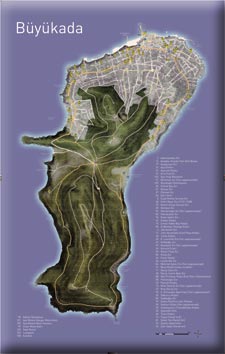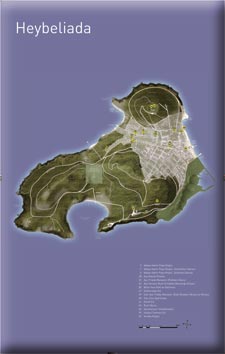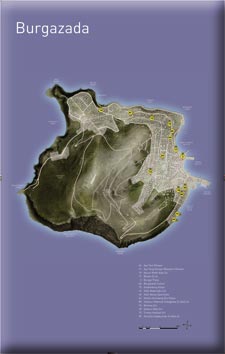Kınalıada - Proti
Kınalıada
- Details
- Created on 18 February 2013
- Last Updated on 11 April 2013
Village Center
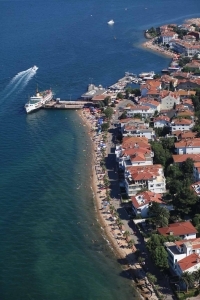 The focal point of the village, here as in the other three major isles, is the vapur iskelesi, or ferry landing, on the northeast shore. The new iskele for the sea bus is just beside the pier for the regular ferry on its south side.
The focal point of the village, here as in the other three major isles, is the vapur iskelesi, or ferry landing, on the northeast shore. The new iskele for the sea bus is just beside the pier for the regular ferry on its south side.
Kınalıada is the only one of the four larger isles that does not have faytons (horse carriages), and so those who want to explore the uninhabited western side of the island must do so on foot or by bicycle. Local residents claim to prefer the absence of horses which renders the island more sweet-smelling than its sisters. In any case, the island is so small that any destination can be reached within a few minutes’ walk.
The Greek Orthodox Church
The Greek Orthodox church is on Çınarlı Köşk Sokağı, a short way in from the shore road. The church is dedicated to the Genissa Panagia Theotokou, the Birth of the All Holy Mother of God, and was founded in 1886. The church is in the form of a three-aisled basilica with a narthex, entered from a courtyard-garden to its south. In the narthex there is a silver-clad icon depicting the Birth of the Virgin. There are other silver-clad icons on the iconostasis, or icon screen, which separates the nave from the sanctuary. The church celebrates the panigiri, or feast-day, of the Virgin’s birth on 7-8 October.
Surp Krikor Lusavoriç, Armenian Gregorian Church
 The Armenian Gregorian church is on Narçiçeğı Sokağı, on the third block in from the shore road. This was the first and only Armenian Gregorian church built on the islands. The church was founded in 1857 and is dedicated to Surp Krikor Lusavoriç, St. Gregory the Illuminator. The present church is the result of a complete reconstruction in 1988.
The Armenian Gregorian church is on Narçiçeğı Sokağı, on the third block in from the shore road. This was the first and only Armenian Gregorian church built on the islands. The church was founded in 1857 and is dedicated to Surp Krikor Lusavoriç, St. Gregory the Illuminator. The present church is the result of a complete reconstruction in 1988.
The altar curtain was taken from the Armenian church of St. Auxent in Trabzon. Behind the altar there is a painting of the Virgin and Christ Child. The altar is flanked by two paintings, the one on the left depicting St. Gregory the Illuminator, founder of the Armenian Gregorian Church, while the one on the right shows St. Nerses, patriarch of the Gregorian Armenian Church in the mid-fourth century. The side altar on the right is dedicated to St. Gregory, who is shown holding a model of the cathedral that he built at Etchmiadzin in Armenia. On the side walls of the nave there are panels containing attractive stone carvings in the medieval Armenian style. One of the panels commemorates the great Armenian composer Gomidas, who had a summer home on Kınalı during the years 1909-13.
Kınalıada Mosque
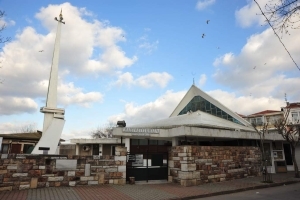 The Muslim community worships in Kınalıada Camii, which stands on the shore south of the iskele. The mosque was built in 1956 by the architect Başar Acarlı in a modern abstract style.
The Muslim community worships in Kınalıada Camii, which stands on the shore south of the iskele. The mosque was built in 1956 by the architect Başar Acarlı in a modern abstract style.
Monastery of the Transfiguration
 The present monastery of the Transfiguration is near the peak of Manastir Tepesi. This was built on the site of the Byzantine monastery of the same name, of which a number of architectural fragments have been built into the katholikon, or monastic church, while others lie scattered around the grounds. After the Turkish Conquest the monastery began to fall into ruins, but in 1722 a group of wealthy Greek merchants from Chios, who were doing business in Istanbul, financed a major restoration, building a new church on the site of the Byzantine katholikon and adding a side chapel dedicated to St. Paraskevi. The iconostasis and episcopal throne are in finely carved wood. The Byzantine icons from the original katholikon are preserved in the Greek Orthodox Patriarchate in Istanbul. The icons on the iconostasis of the present church are Russian works sent in 1723 to the patriarch Jeremias III from Tsar Peter the Great.
The present monastery of the Transfiguration is near the peak of Manastir Tepesi. This was built on the site of the Byzantine monastery of the same name, of which a number of architectural fragments have been built into the katholikon, or monastic church, while others lie scattered around the grounds. After the Turkish Conquest the monastery began to fall into ruins, but in 1722 a group of wealthy Greek merchants from Chios, who were doing business in Istanbul, financed a major restoration, building a new church on the site of the Byzantine katholikon and adding a side chapel dedicated to St. Paraskevi. The iconostasis and episcopal throne are in finely carved wood. The Byzantine icons from the original katholikon are preserved in the Greek Orthodox Patriarchate in Istanbul. The icons on the iconostasis of the present church are Russian works sent in 1723 to the patriarch Jeremias III from Tsar Peter the Great.


